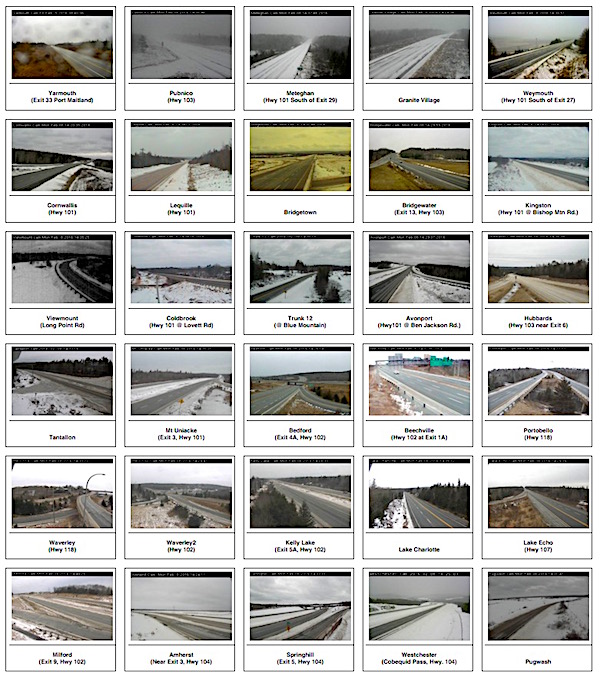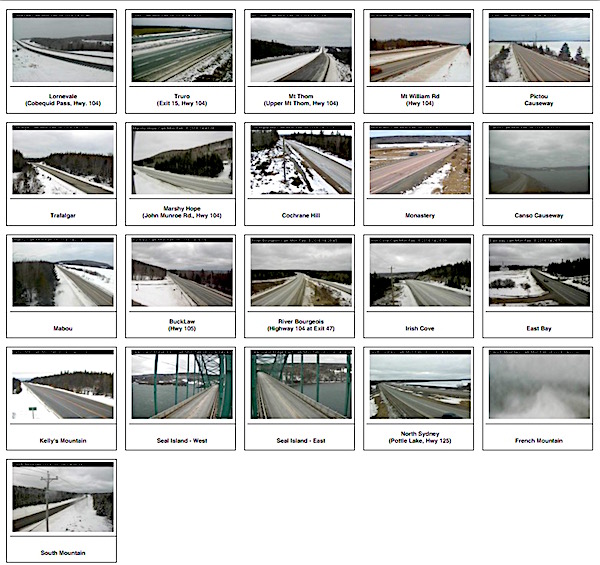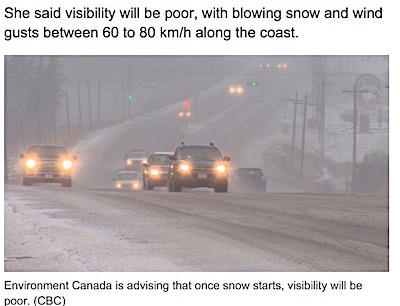08 Feb Cancelling schools today for tonight’s (probably exaggerated) storm
Here is a screenshot of all 51 Nova Scotia highway cams as of 2:50 p.m., Monday, February 8, a day on which every school on mainland Nova Scotia west of Antigonish was cancelled:


Only four of the 51 cams show any snow cover on the roads they monitor. Three are at the extreme southwest end of the province, where the storm was just getting underway by mid-afternoon; the fourth is in the Cape Breton Highlands. Forty-seven roads were clear; the four with light snow cover posed no problem to professional drivers of vehicles equipped with snow tires.
Yet the Annapolis Valley, Chignecto-Central, Halifax, South Shore, and Tri-County regional school boards closed all schools, all day. Chignecto-Central Regional School Board cancelled all schools in Hants County. The Acadian School Board cancelled its mainland schools. Université Sainte-Anne, Acadia, Dalhousie, Mount St. Vincent, NSCAD, and Saint Mary’s Universities all shut down.
Nova Scotia schools no longer have zero tolerance of snow. They have zero tolerance of the possibility of future snow.
Let’s tally up the financial cost to the province of this one day of weather paranoia:
Approximately 102,000Upwards of 100,000 school children lost a day in school unnecessarily.- Thousands of teachers and school board staff got a paid day off. [Update: a reader tells me HRSB staff worked a half day.]
- Roughly 68,000 households had to scramble to make last minute child care arrangements (based on an estimated 1.5 students per family).
- Some of those parents lost a day of work.
- Thousands of employers endured absenteeism and paid work time diverted to managing the school boards’ indifference to community needs.
- [Update: The province sent provincial employees home at 1 p.m., although the storm did not hit Halifax until much later.]
Every student in these school districts was subtly reinforced in what has become a core lesson of Nova Scotia’s school curriculum: If things get tough, or even if you’re a little bit worried they might get tough later on, the right response is to give up and stay home. School doesn’t matter. Work doesn’t matter. Avoiding hard things is all that matters.
The problem begins with Environment Canada, which has built institutionalized exaggerations into its forecasts in the form of weather advisories, alerts, bulletins, and warnings covering mostly routine weather events. It compounds these with fake measurements for “wind chill” and “humidex” that substitute notional exaggerations for actual, observable measurements.
The news media torques reality further by focusing its reports on the (improbable) extreme in a range of probabilities. Thus, a storm Environment Canada expects to drop 10 to 20 cm of snow in various parts of the province, with a possible 25 cm in certain areas due to local conditions, is reported as “DUMPING” (scare word) “UP TO” (salesman’s weasel phrase) 25 CENTIMETRES (misrepresenting the extreme as the mean) ON NOVA SCOTIA (journalistic synecdoche substituting the whole for some of its parts).
This forces school boards to prepare for a major storm when a routine snowfall more accurately reflects the forecast.
The media also habitually blurs storm timelines. CBC reported this morning that tonight’s storm would be “moving east through the day,” when it didn’t even hit the extreme western end of the province until after 2 p.m. It found an Environment Canada meteorologist to predict poor visibility in blowing snow, then illustrated the point with a photo showing a different storm, somewhere, sometime in the past:

Here the public broadcaster ignored journalistic norms for truth in photography. No caption alerted readers that the photo depicted a different event, or labeled it, “file photo,” “artist’s conception,” “not exactly as illustrated,” or “fear-monger’s fantasy.”
I’m picking on the CBC here, but everybody does it. They misrepresented tonight’s storm as today’s. They mislabeled a significant winter storm as a blizzard (a word that once had real heft and meaning). They portrayed the unlikely as the probable. And then they led every newscast of the day with their layered falsehoods so that everyone in the province cowered indoors until the first flakes of light snow reached Halifax about five p.m.
Tuesday might well prove to be a reasonable snow day. Monday was not.
Someday, future Nova Scotians will look back on this time with bemusement.
“What was wrong with those people,” they will ask.
But today, in a province struggling to keep up with a world leaving us in its wake, fearful disengagement from challenges is exactly the wrong path.
PS to those readers composing emails that begin, “If only one child is saved…”: Consider that no society has ever enhanced its safety by exaggerating risks. Routine exaggeration of risk, and failure to weigh risk against other social values, makes society more dangerous, not less.

